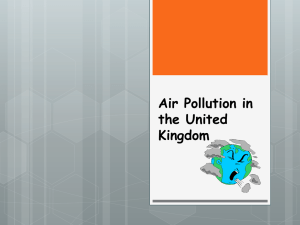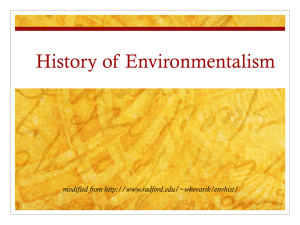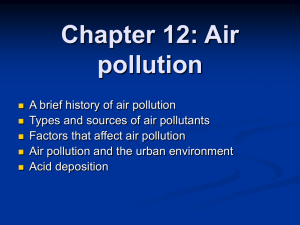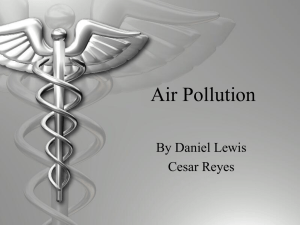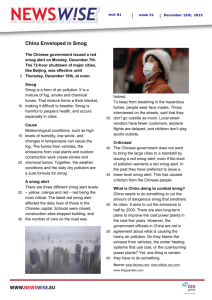Grand societal challenges and the reorientation of incumbent
advertisement
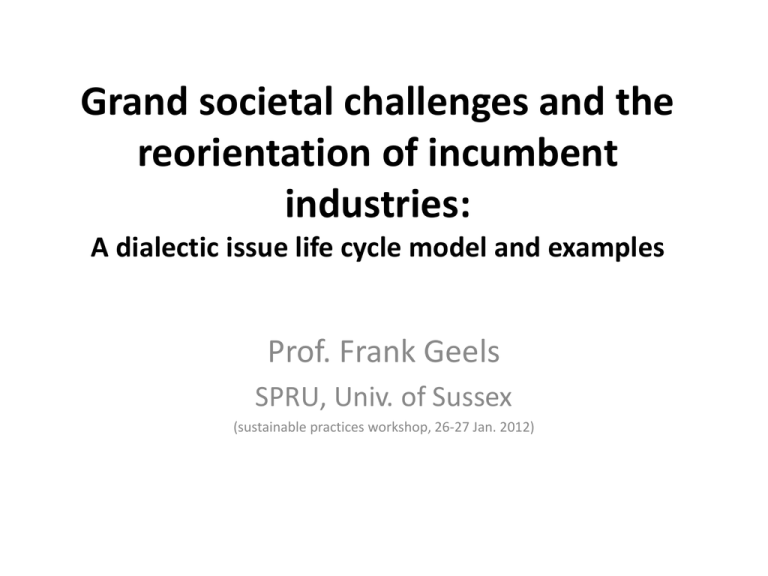
Grand societal challenges and the reorientation of incumbent industries: A dialectic issue life cycle model and examples Prof. Frank Geels SPRU, Univ. of Sussex (sustainable practices workshop, 26-27 Jan. 2012) Structure 1. 2. 3. 4. 5. Introduction/motivation Theoretical framework Case study 1 Case study 2 Conclusions 1. Introduction Why at this workshop? • NOT about consumption practices • But it is about: - “problems such as climate change” Issue life cycles (the dynamics of problems) - Political economy much talk in transitions literature about power and politics, but remains vague (often rather discursive) - “Questions of the interaction between political and regulatory frameworks”. And industry/technical innovation, markets and civil society/discourse. Background (innovation studies) • New topic: Grand societal challenges (climate change, energy security, transport and resource efficiency, food safety, obesity, health and aging) • Linked to: Systemic transitions + directionality of innovation (rather than speed and output) • Focal actor: Industry (population of firms) • Embedded in organizational field (link to my previous work) Organizational field S up ply ch ain: * m aterial su pliers * co m pon ent sup pliers * m achine suppliers U sers P ro duction , indu stry : * firm s * engin eers, designers R esearch : * univ ersities * technical in stitutes * R & D laboratories S ocietal gro ups: P olicy, pub lic authorities: * E u ropean C om m ission, W TO , G AT T * G overnm ent, M inistries, P arliam en t * L o cal authorities and executive branches (e.g. G reenpeace, m ed ia, bran ch organisation s) Lock-in, inertia, path dependence Research questions 1.How do societal problems emerge and develop? 2.How do industries respond to societal problems? When do they implement substantial responses (i.e. overcome lock-in)? Research strategy • Develop an enriched issue life cycle model • Confront the model with in-depth case studies: US car industry and: a) Local air pollution (1945-1985) b) Car safety (1910-2000) c) Climate change (1990-2010) 2. Theoretical framework Issue life cycle theory (Business & Society) Public attention Dramatic event or trigger Voluntary or government mandated resolution Secondary trigger A B C Expectational gap(s) has opened Debate; coalitions develop possible redefinitions of the gap/issue Implementation; monitoring by most interested parties A = The issue re-emerges because the resolution is not satisfactory or new issues emerge from the resolution B = The issue is satisfactorily resolved as long as the resolution mechanism remains in place. C = The issue dies because of further social, economic, political, or technological change. Mahon and Waddock (1992) Tombari (1984) Rivoli and Waddock (2010) Strengths • • • • a) b) c) d) Issues/problems have temporality Issue dynamics are socially enacted Social construction + power/politics Multi-dimensional: Activists/social movements Public opinion Political debates Political decisions (+ implementation) Weaknesses 1. Too little conflict/struggle (teleological unfolding) 2. Too little corporate strategies 3. Linear sequence (problem in many phase-models) Improvements 1) Link to broader industry framework 2) Add more strategy and struggle/conflict 3) Flexible with phases: backwards, forwards Triple embeddedness framework of industry Inspired by: • institit. theory: org. fields • Structuration theory (‘rules and resources’) • Regulation theory (mode of production, regime of accumulation, mode of regulation) • Scott’s (1993) institutional pillars • Evolutionary theory: adapting to selection pressures Industry regime Knowledge, capabilities (technical regime) Beliefs, interpretations Mission, behavioural norms Regulations Civil society, social movements, public opinion Customers Industry Suppliers Politics Task environment Firms Institutional environment Framing, PR and issue management strategies • Ignore, deny, downplay problems • Emphasize uncertainties and contest the science • Emphasize costs and difficulties of solutions Adjust storylines to increase (Benford and Snow, 2000): • • • • • Actor credibility Empirical fit Centrality Experiential commensurability Macro-cultural resonance Corporate political strategies (Hillman and Hitt, 1999) 1. Information and framing strategy - industry research institutes to build expertise - contest the science - commission research reports - testify as expert witness in hearings 2. Financial incentives strategy - make contributions to political parties - pay fees to politicians for speeches - offer politicians lucrative jobs at the end of their career 3. Organized pressure strategy - create fake grassroots organizations (‘astroturf’) - create industry associations that speak for the industry - mobilize employees, suppliers, customers to pressure their representatives 4. Direct lobbying strategy - hire lobbyists to work politicians - mobilize CEOs to speak with politicians 5. Confrontational strategies - oppose laws through litigation - threaten policy makers with plant closures - refuse to implement or obey policies Economic positioning strategies • Porter: low cost, high performance, niche market • Supply chain management, marketing strategies • Corporate strategy/mission Innovation strategies Tension: Radical and incremental innovation • Exploitation-exploration (March, 1991) • Ambidextrous organizations (Tushman) Radical innovation not just about knowledge flows (innovation systems), But also about beliefs and strategic commitment Rothwell (1992) Tactical factors Strategic factors Effective linkages with external sources of know-how Top management commitment to, and visible support for, innovation Effective functional integration; involving all departments in the project from its earliest stages Long-term corporate strategy in which innovation plays a key role Careful planning and project control procedures Long-term commitment to major projects. Temporal unfolding of pressures and responses (ideal-type) Phase 1: Problem definition and framing struggles Phase 2: Rising public concerns and defensive industry responses Phase 3: Political debates/struggles and defensive hedging Phase 4: Political regulations and diversification Phase 5: Spillovers to task environment and reorientation Different issue cycles 3. Longitudinal case study: Air pollution, technical innovation, and the American car industry (1943-1985) 27Los Source: University of Southern California Digital Library and Angeles Times photographic archive, UCLA Library Phase 1: Issue emergence and sensemaking attempts (1943-1953) Pressures: • Severe smog events in California (1943, 1948) • Public concerns and protests Source: University of Southern California Digital Library Smog protestants at Board of Supervisors, 1947 • Symbolic policy statements (concern) Source: University of Southern California Digital Library Smog committee at District Attorney's Office, 1947 • Research into causes (sensemaking struggles) • Initial blame to stationary sources (oil and waste burning) • Haagen-Smit research: car exhausts + smog chemistry Source: University of Southern California Digital Library Smoking stack from Mercer Hotel, LA, 1949 Car industry responses: • Unconcerned • Rejected automobile as cause Phase 2: Policy learning and defensive industry responses (1953-1960) Pressures: • 1953 ‘five-day siege of smog’ increased public concern Stamp Out Smog meets with public officials Source: Jacobs and Kelly (2008:192) • Activist movement: Stamp out Smog (1958) • Policy debates and early Federal involvement • Federal Air Pollution Control Act (1955) stimulated further studies on the causes and (health) effects of air pollution • First National Conference on Air Pollution in 1958 Car industry responses • Industry acknowledges the issue (denial impossible) • Framing strategies: a) Science base uncertain b) California is special case (no federal involvement needed) • Incremental R&D programme by Vehicle Combustion Products Committee (1953) • But also collusion: agree not to compete Phase 3: Increasing public concern, early legislation and industry delay (1960-1970) Health risk framing of air pollution in the early 1960s Source: Washington Star, reprinted in U.S. Department of HEW (1966:3) Pressures •Growing scientific understanding of health effects •New framing in public discourse • Increasing anxiety •Smog problems spread to other states (New York, Philadelphia) •New activist groups: Clean Air Council (1967) and the Group Against Smog and Pollution (GASP) (1969) •Coalition with medical establishment •Californian legislation: Motor Vehicle Pollution Control Act (1960) •1963 Clean Air Act (CAA): weak, no standards, but do more research Source: Scanned cover of the book Decreasing legitimacy of car industry: at any speed 1) ‘anti-trust caseRalphofNader’s theUnsafe century’ (1969): conspiracy re. pollution control devices 2) Secret recall campaigns: 20% of cars recalled for safety defects between 1960 and 1966 3) Safety issue: Nader (1965) and regulations (1967) Public perception: car industry no regard for public interest. Needs to be forced by law Car industry responses Source: Washington Post, reprinted in U.S. Department of HEW (1966:53) Framing strategies: • ‘regulation is not needed’ (Voluntary’ installation of Cartoon mocking the reluctance of the car devices in 1960) industry to install control devices • Solutions are expensive (mocked in newspapers) Incremental innovation strategies • • • • • PCV valves evaporation-control systems (ECS) transmission controlled spark (TCS) thermovacuum switches (TVS) air injected reactor (AIR) Radical innovation strategies • Suppliers (chemical industry) offer catalytic converters • Industry rejects, but starts R&D Phase 4: Tough legislation and resisted implementation (1970-1977) Pressures • Peak in public attention • Air pollution resonates with broader cultural trend of environmentalism (Earth Day, 1970) Source: Getty images Earth Day One (April 22nd, 1970) • Increasing frustration with car industry • Political jockeying Muskie and Nixon Result in tough Clean Air Act (1970) Figure 7: Number of air pollution control bills introduced Car industry responses Framing strategies • CAA is threat to US economy (imposes costs) • Emphasise trade-offs with fuel efficiency (1973) Political strategies • Lobby senators to kill the bill • Complain directly to President • Litigation tactics to fight CAA implementation Innovation strategies • Continue incremental innovation • But also improve catalysts Innovation race (patents) Source: Google News Archives • GM breaks industry front and installs catalytic converters (1975) • Advertising GM’s 1975 add of catalytic converters Phase 5: Industry fightback, implementation delays, and institutionalization (1977-1985) Pressures • Decline in public attention • Postponement of 1977 standards • Other issues: oil crises, economic problems (late 1970s), unemployment • Policy makers more interested in saving car industry than air pollution • New anti-regulation discourse (causing economic problems) • Reagan (1981) attempts regulatory rollback Car industry responses Economic problems (weak demand + Japanese competition) • Economic problems embolden industry: refusal to comply with 1978 standards • Industry supports anti-regulation discourse • Ask policymakers for support Innovation strategies • Slowing down patent race • But install three-way catalyst (1981), which reconfigured the engine Pattern matching Relatively good match with first three phases Deviations in fourth and fifth phase, due to: a) Decreasing pressure from public opinion b) Limited spillovers from the issue to consumer demand c) Rise of competing issues d) Strong resistance from the powerful car industry 50 4. Case study 2: Safety (1900-2000) Main dynamic • Until 1960s: 3E-framing dominant (Engineering, Education, Enforcement) • Car design was kept off agenda • Alternative framing in 1950s: crash engineering and medical establishment Clash between professional communities (not driven by ‘the public’) Nader (1965) + public outrage + policy learning National Highway Traffic Safety Act (1966) Followed by resistance and implementation struggles (seatbelt vs. airbag controversy) Difference with case 1 Public attention continuous rise spillover to consumer preferences in late 1980s Relative importance of decision criteria for car purchase ‘Safety did not sell’ in 1950s and 1960s, but does in 1990s Market demand stimulates major industry effort Automobile safety patents (based on USPTO) Lesson: Industry fights regulation to delay issue progression But when issue spills over to markets, industry can accelerate and mobilize resources 5. Concluding comments • Industries tend to postpone substantial solutions to ‘issues’ • External pressures important: public opinion, activists, politics, markets • Pressure around issues develops gradually and dialectically (conflict) • Issues go up and down • What about climate change? Decreasing public attention absolute # articles 6000 The Guardian 5000 The Times The Independent 4000 Daily Express 3000 2000 1000 2011* 2010 2009 2008 2007 2006 2005 2004 2003 2002 2001 2000 1999 1998 1997 1996 1995 1994 1993 1992 1991 1990 0 2011* 2010 2009 2008 2007 2006 2005 2004 2003 2002 2001 2000 1999 1998 1997 1996 1995 1994 0,8 1993 1,0 1992 1991 1990 normalized: max=1 The Guardian The Times The Independent Daily Express 0,6 0,4 0,2 0,0 Volatile and low carbon price • Kyoto successor postponed (limited political pressure) • contesting the science (UEA ‘climate gate’) • Debates (Newsnight) on costs of green energy Maybe the climate change issue moves back to earlier phase Need to analyze pressures and responses (third case next year?)

